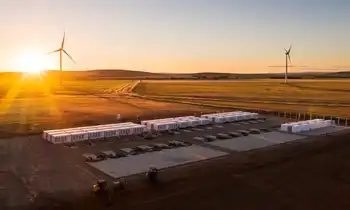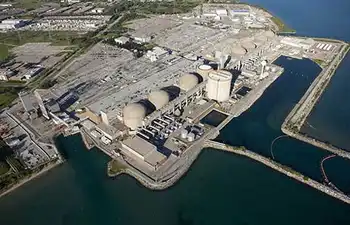Now Over, Power Crisis Continues to Have Impact on Northwest
- The power crisis of 2001 hit the Northwest quickly and with little warning, leaving aluminum workers without jobs, young salmon dead at dams and utility managers scrambling to buy electricity at any price. It also shook citizens in Oregon and Washington into turning down thermostats and preparing for brownouts.
Then -- poof -- the crisis evaporated.
Wholesale electricity prices are now their lowest in more than two years. The region's electricity demand is 15 percent below last year's. The odds of a blackout this winter, pegged at 23 percent early this year, are now less than 5 percent.
But things are hardly back to normal. The vanishing power crisis changed the Northwest.
The Bonneville Power Administration, which supplies nearly half of the Northwest's electricity, raised its wholesale prices 46 percent Oct. 1. That plus higher electricity costs incurred earlier this year have driven up retail rates at 52 utilities across Oregon, Washington and Idaho an average of 21 percent. Portland General Electric's rates are up 41 percent.
Some businesses and utilities locked in long-term contracts when future supplies seemed uncertain and prices soared. Others leased or bought expensive natural gas-fired generators. Now those companies are stuck, paying 10 times or more the current wholesale rate for electricity.
Conservation efforts reduced demand by 7 percent to 9 percent, about half of the 15 percent reduction in electricity use. The number of renewable energy sources, including wind turbines, proposed in Oregon, Washington and Idaho has increased from three two years ago to 15 today.
"For 20 years, people have been asleep about energy," said Rachel Shimshak, the executive director of the Renewable Energy Project, a Portland-based nonprofit. "Over the last year, we got quite a wake-up call."
In early 2000, the idea of a power crisis here was inconceivable. The Pacific Northwest basked in electricity rates by far the lowest in the nation. More than 75 percent of Northwest electricity came from a seemingly robust hydropower system driven by rain and snowmelt, not foreign oil or volatile natural gas.
Then two things happened: The failure of deregulation in California drove the wholesale power market into an unprecedented spiral with wholesale prices spiking at $3,250 a megawatt hour last Dec. 8, up from $29.31 the year before. And the Northwest was hit with a near-record drought.
Fueled by economic growth, electricity demand in the Northwest had outstripped the region's ability to supply power in a drought year.
Bonneville acts The Bonneville Power Administration, under the leadership of acting administrator Steve Wright, responded sharply. First Bonneville declared a power emergency, an action that let it increase electricity production at dams by suspending federally ordered measures to help salmon. Then it began paying aluminum smelters to halt production and stop using BPA electricity. Finally, it asked its other customers, including utilities, to cut their electricity demand from Bonneville by 10 percent.
Bonneville took the actions because the federal agency seemed in deep trouble. It was contractually bound to supply utilities and companies across the region with about 11,000 megawatts of electricity. The 30 federal dams and one nuclear power plant that supply Bonneville produce only 7,500 megawatts in a drought year. Bonneville had locked in wholesale purchases of about 1,000 megawatts. Agency officials in March projected that making up the 2,500 megawatt shortfall by buying electricity on the spot market would cost $3.2 billion, three quarters of Bonneville's 2001 annual budget of $4.2 billion.
Bonneville never got into that hole. By sending water through turbines instead of over spillways, Bonneville was able to store water in reservoirs and still meet regional power demand. And overall power demand is now sharply lower, partly because of Bonneville's buyout program and partly because of the slowed economy and increased conservation.
Overall, according to Wright, Bonneville and the region came through with flying colors.
"We avoided the potential for losing a billion-dollars-plus, we avoided scarring our credit, and we preserved the long-term value of this system," Wright said recently. "Under the most difficult of circumstances, the long-term assets of the region have been preserved."
But the cost was high.
Decreasing power demand, including the buyout of aluminum companies, cost Bonneville $206.4 million and contributed to the agency's rate hike. Nearly 5,000 aluminum workers lost their jobs. And Bonneville's decision to cut the amount of water it sent over spillways by 83 percent boosted the death rate of young salmon.
Wright and other Bonneville officials say a salmon massacre was avoided because many Columbia Basin salmon -- including about 90 percent of the young salmon that come down the Snake River from Idaho -- were carried past dams this year on barges operated by the U.S. Army Corps of Engineers
Still, Eric Bloch, one of Oregon Gov. John Kitzhaber's representatives on the Northwest Power Planning Council, says Bonneville caused too much harm to salmon.
"Clearly Bonneville overshot the mark," Bloch said. "If you look at the situation we are in now, when we are awash in power that is relatively inexpensive, we had significantly more salmon mortality than we needed to have."
Tribes with treaty rights to salmon are furious that the spill program was largely abandoned. And while conservationists say they understand why little water was spilled in April and May, they say all the water called for in the federal salmon plan should have been spilled in June, July and August.
If Bonneville sends water over spillways instead of through turbines, it must go to the wholesale market to buy electricity it is bound by contract to sell to utilities and industrial customers. Because electricity was trading for an average $290 a megawatt hour in April and May, a full spill program in those months would have been financially crippling. But the average electricity price fell to $57 a megawatt hour in June, July and August.
"BPA's water policy was out of step with the reality of power supplies and prices," said Mark Glyde of the Northwest Energy Coalition in Seattle. "By summer, demand was down and power was affordable. They should have spilled more water."
Actions defended Wright disagrees. For one thing, he said, there was no way for him to know at the time that a recession, compounded by the Sept. 11 attacks, would lower Northwest electricity demand so dramatically. Also, he said, there was no way to know that electricity prices would keep dropping.
"To have chosen to have done a full spill program would have been a very stupid decision based on information that was available to us at that time," Wright said. "Those are good, sound decisions, and I don't regret them."
Even with the steps Bonneville took, many were burned by the quick-to-vanish power crisis. Two utilities in Southwest Washington, Clark County Public Utility District and Cowlitz County Public Utility District, were among those most hurt when power prices plummeted.
Clark PUD spent $100 million early this year, when it looked as though power prices would not come down: $64 million on a long-term contract to buy electricity and $36 million to lease natural gas-fired generators. Cowlitz spent $31 million to lease gas generators that produce electricity at about $150 dollars a megawatt hour.
Wholesale power prices are now hovering around $23 a megawatt hour. That leaves both utilities buying or generating electricity that costs more than power they can buy on the wholesale market. Both utilities have imposed rate increases of about 45 percent
"We felt we had to make a move to protect our ratepayers, but unfortunately, it didn't work out for us," said Denny Robinson, the general manager of the Cowlitz PUD. "Power prices were as unpredictable going down as they were going up. It's not been good."
Related News

Why Canada's Energy Security Hinges on Renewables
TORONTO - Oil, gas, and coal have been the central pillar of the global energy system throughout the 20th century. And for decades, these fossil fuels have been closely associated with energy security.
The perception of energy security, however, is rapidly changing. Renewables form an increasing share of energy sectors worldwide as countries look to deliver on the Paris Agreement and mitigate the effects of climate change. Moreover, Russia’s invasion of Ukraine has demonstrated how relying on fossil fuels for power, heating, and transport has left many countries vulnerable or energy insecure.
The International Energy Agency (IEA) defines energy security as “the…




